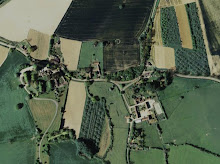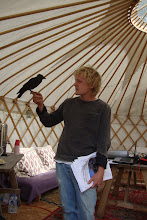
Looking down towards Chipping Campden from one of the only old cherry orchards left in this part of Gloucestershire. In this area, it's better to focus on what is left to preserve rather than dwell on what has been lost.


This is James Stanley, a farmer who lives locally to me. He looks after several fantastic old orchards that I spotted via Google Earth. Today he was kind enough to take me on a guided tour of his orchards and the weather couldn't have been better for it. This tree is a Blenheim Orange. I've encountered a few old ones like this - they're impressive trees and always recognisably by the gnarly bark. It's a tasty late dessert apple variety found in c. 1740 as a 'gribble' by a gardener, Mr Kempster, on the boundary wall of Blenheim Palace in Woodstock. (A 'gribble' is an apple tree that has germinated naturally from a pip in the countryside, in case you were wondering!).

It is a classic traditional orchard, with all the trees widely spaced on standard rootstocks that has enabled the tress to grow large enough to cope with cattle grazing for many years. James was telling me how he used to pick from all the trees using tall ladders and sell the fruit locally. Sadly now there is no market for the varieties except intermittent custom from local cider-makers. Hooray for cider, again!

This is an interesting tree. James has a whole row of these, with spectacular claret fruit. James' father used to call these "Devlins".

Looks can be deceiving though, as they taste pretty cardboardy and apparently only really sold during the war when everyone was short on options.

Beautiful perry pear trees again, reminiscent of an orchard in Bledington and my new friends Helmut and Monika's farm in Switzerland.

Because it has been so dry and sunny recently the trees have kept their leaves really well - look at the colour of this perry pear!

Sadly this orchard has a real issue with 'generational bias', like many traditional orchards. If they no longer have a commercial use then there is no incentive to 'gap up' when trees die and an orchard with no young trees will slowly fade away...

Is this Ebrington's last plum orchard?



beautiful pictures. so sad to see orchards dying out,however, many new trees are being planted in somerset. our town clevedon even has a "renovated" orchard with cider apples. the land at the back of my house was all orchards 100 years ago.i have planted 3 perry trees & 3 cider apples in my garden so at least one corner of clevedon will have apples!
ReplyDeleteThe plum orchard at Ebrington is in a bad way with many trees dead and dying due mainly to silver leaf .It is important to know the time of year to prune these trees .Mid to late spring is the ideal time and I would recommend pruning right up to harvest especially with orchards of this size. All live wood prunings should be removed or burnt on site the silver leaf fungus doesn't survive on dead wood ,but good fungi do, so leave this for wildlife
ReplyDeleteThank goodness for Natural England and thier advisers that orchards like this have beneftted from HLS grants which have sadly come to an end .
If anyone needs advise go to The Gloucestershire Orchard Trust website which has a link on this blog